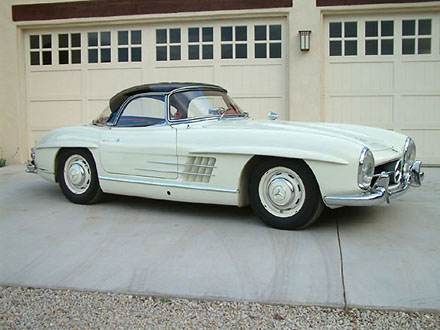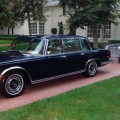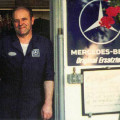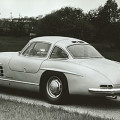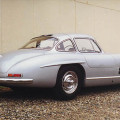Sometime in March 1997 my friend John Ling told me about an old Mercedes-Benz for sale at a Lincoln-Mercury dealer near Milwaukee. The car, said to be a convertible, was being sold to settle an estate. A week or two later, John had time to drive to the dealership and check out the car. When he did so, he called me excitedly and said that the “convertible” was, in fact, a beautiful 300SL Roadster! He thought the car had never been restored, and it seemed to be in near-mint original condition. Excited, I arranged to fly into Milwaukee to see the Roadster the next week.
Special Roadster
Before doing so, I called the salesman representing the car and asked what he knew about it. He said that it had belonged to a gentleman named Harger Dodge. That name sounded very familiar, but I wasn’t sure where I’d heard it. He told me it was a 1962 Mercedes-Benz 300SL Roadster, white with a red leather interior and that a lot of documentation came with it. The car had always been serviced by the local Mercedes-Benz dealer, and its odometer currently read 83,000 miles. The chassis number, 198.042.0002958, indicated that the car had been produced in late 1961 then sold and registered as a 1962 model. Out of the 1,818 Roadsters built, this was one of 478 delivered with disc brakes.
When I flew in to see the Roadster, I found it stored indoors at the Lincoln-Mercury dealership. Despite the poor lighting, I could immediately see that this car was special. It was definitely unrestored and appeared to be in superb condition. It looked as if it just needed a thorough servicing and cleaning after a year or so of sitting unused.
When we reviewed the Roadster’s paperwork in the salesman’s office, the car’s history began unfolding. Its one and only owner, Harger Dodge, had once been MBCA’s national president.
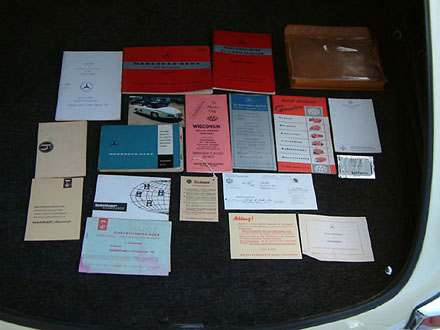
The Paper Trail
The original sales invoice for this 300SL shows that Harger ordered and pad for it on January 20th, 1962 at Burnham Motor Sales in the Milwaukee suburb of West Allis. Burnham was then an authorized dealer for Studebaker Packard as well as Mercedes-Benz and DKW/Auto Union. Harger arranged to take delivery of his new Roadster at the factory later that summer, during MBCA’s annual Safari, when 29 other new cars were delivered. He first saw and drove his new 300SL at Sindelfingen on the afternoon of September 11th, 1962.
This Roadster’s base price, with hardtop and soft top, was $11,670. Accessories listed on the sales invoice included a crate for the top, $18.59; a radio, $295.10; seat belts, $23.95; license-plate frames, $9.30; and undercarriage protection. $15.00, for a grand total of $12,031.94. Harger traded in a “1959 Mercedes-Benz” valued at $3,796.05. At that time you could have bought two new Cadillacs for $12,000.
The documentation surviving today with the Roadster is amazing: its original sales invoice; the large and small parts catalogs; an original hardbound workshop manual; the factory data card; a service coupon book; the owner’s manual; a Mercedes-Benz owners service policy certificate; the Becker Mexico radio and Hirschmann antenna instruction booklets; and a Becker Radio service directory. It even had the little cardboard tag that said “Hirschmann” with the string that had attached it to the antenna on the day the car was delivered. Among the artifacts Harger had saved since his 1962 trip was an unused “wet nap,” still in its foil wrapping, for wiping fingers after a meal on the KLM DC8 flight from Idlewild, and a notepad from the Grand Hotel Dolder on Kurhausstrasse, next door to the Dolder Golf Club, in Zurich, Switzerland.
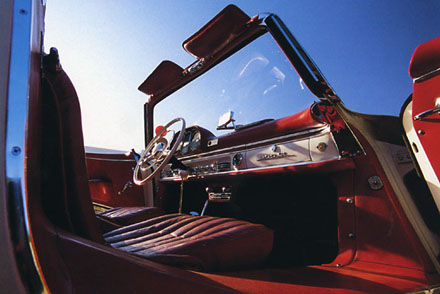
Maintenance the Key
Occasionally I encounter cars with extremely low mileage, but a low odometer reading often indicates that the vehicle was parked and forgotten, sometimes for decades. Improperly stored cars can accrue unnecessary mechanical and cosmetic damage. I’ve seen this happen time and again. Happily, this Roadster has a different story, mainly because Harger was a stickler for detail. At least twice yearly, usually in the spring and fall, the car went to the Mercedes-Benz dealership for regular maintenance. Harger would also compile a list of other items to be dealt with. He would give the list to Service Manager Lothar Altmann, detailing such tasks as he felt necessary to keep the Roadster looking and performing as new.
Even the smallest details were attended to. For example, one memo to Lothar indicated that “when leaving the garage and entering Lake Drive, drive slowly to try to determine the creaking noise which disappears after the car is warmed up.” As I read through the invoice attached to the memo detailing the work performed, I saw that several bushings were lubricated or changed, silencing the squeaks. Harger died in 1992, but his wife, Harriott, continued to have the car regularly serviced until she passed away in 1996. The service coupon book is stamped and dated from the first 500-mile service to the very last service (number 46), at 82,264 miles on August 14th, 1995.
A unique accessory with the car was a small wedge-shaped cushion for the driver’s seat, made from the original 1060 red leather. As we understand it, Harger’s wife was minute, so she couldn’t see over the steering wheel, even with the seat all the way forward. To drive the roadster, she needed this cushion.
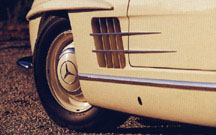
Rejuvenation Process
Back to the present. After a bit of haggling at the Lincoln-Mercury dealership, a price was decided, and we struck a deal. I had the car transported to my restoration shop, then in Kalamazoo, Michigan. The car had sat unused for several years while the estate was settled, so we went through its mechanical components to make sure everything had been serviced and was still in good order. We also replaced the original rubber seats on the doors and hood.
Cars that have managed to survive unrestored are beginning to be highly prized and appreciated. After all, a car can be original only once. There is a growing awareness of this fact. Would you repaint a Rembrandt because it was less than perfect? As an antique or artifact ages, it becomes more fragile. The emphasis is, of course upon conservation. You must approach maintenance and preservation carefully and do the work without removing or damaging original surfaces and finishes. Our goal was to make the car reliable yet preserve its original look.
This Roadster’s leather was in beautiful condition, still supple, with a certain appropriate patina. It required only cleaning with mild soap, followed by treatment with a special conditioner to help maintain flexibility The carpets were carefully shampooed. Having seen only routine maintenance, the engine compartment was remarkably original. Using mild detergents and soft brushes, we carefully cleaned the engine compartment and components. The chrome was in excellent condition, and the only piece that needed to be re-plated was a front bumper end that I had unfortunately scraped while pulling the car into the garage. Original paint doesn’t have the same brilliance or perfection that can be achieved today with modern two-stage urethane systems, but this car’s original finish has a look and feel almost impossible to duplicate. It just looks right.
Harger’s car was meticulously maintained, so it has a harmonious feel, a certain integrity, rarely found in restored cars. Sink into the drivers seat, turn over the motor, and it starts almost instantly. As you drive off, the clutch and gears engage smoothly. The car still feels “tight” and handles superbly, almost seeming to drive itself.
Harger apparently liked gadgets. A 300SL Roadster originally had two Bosch horns. Maybe Harger wanted to be noticed when he honked, because a total of five 300SL horns were bolted to a bar under the front bumper. These were connected to a special Bosch relay that created different horn/sound combinations. The first time I pushed the horn ring, the horn honked not once but three times, which was a bit disconcerting until I figured out what was going on.
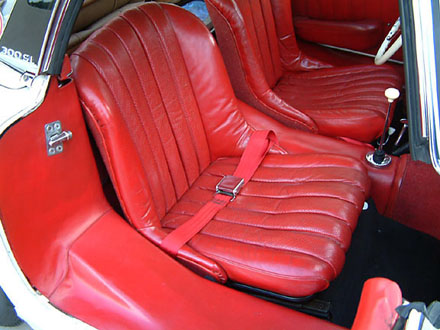
A Certain Feel
One interesting facet of original cars is that they accurately represent what the car really was when new, albeit with a certain amount of aging that is inescapable in anything as time passes. You get a feel for the original craftsmanship and quality. Restored cars, while beautiful and often near-perfect cosmetically, are more representations of our time, when people have come to expect the near-perfection that machines and robotics are capable of creating.
Fifty years ago a lot of handwork went into creating a 300SL. It wasn’t perfection that the workers were after. They were certainly fine craftspeople, but they were tied to a production schedule, not to mention a budget. A factory trimmer didn’t have the luxury of time that today’s restorers enjoy. Today’s shop manager might budget 40 hours to restore a pair of leather-covered seats, but the craftsman who originally made them might have had only an hour or two to sew and assemble the cushions.
Although restored cars attempt to copy the originals, they rarely succeed. It is impossible to exactly duplicate original techniques and materials, and it is impossible to duplicate the patina that time creates. Harger Dodge’s Roadster is a wonderful example of a fine car that has been extremely well taken care of, and 42 years later it provides us with insight into what a 300SL Roadster drove and looked like in its heyday.
